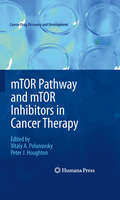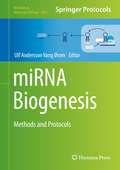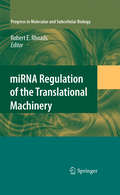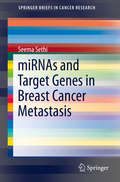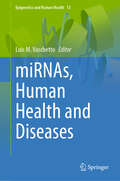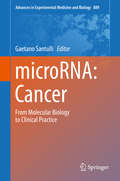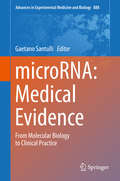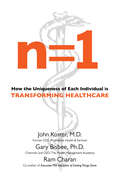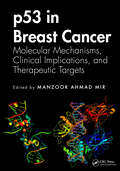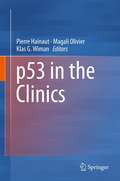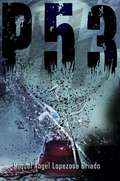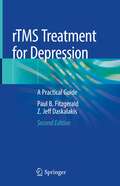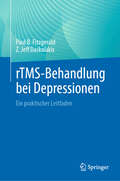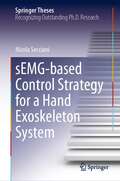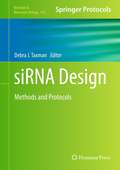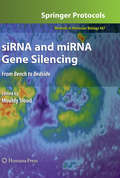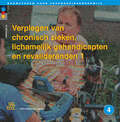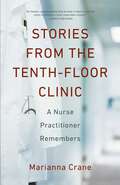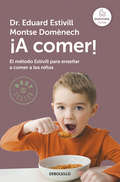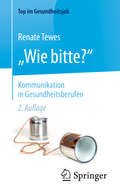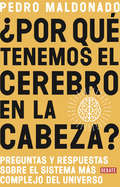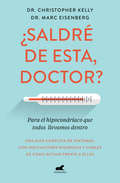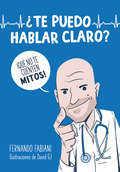- Table View
- List View
mTOR Pathway and mTOR Inhibitors in Cancer Therapy
by Peter J. Houghton Vitaly A. PolunovskymTOR Pathway and mTOR Inhibitors in Cancer Therapy provides an up-to-date survey of the rapidly advancing field of cancer therapy. Our understanding of the mechanisms involved in cancer genesis and progression underwent unprecedented expansion during the last decade, opening a new era of cancer treatment – targeted therapy. The surge in this area results in no small part from studies conducted jointly by basic health scientists and clinical investigators. It is our hope that this book will help foster even further collaboration between investigators in these two disciplines. In this work, experts in TOR signaling have contributed in two thematic areas: mTOR Signaling and Cancer Therapy (chapters 1 - 8) and Therapeutic Targeting Downstream of mTOR (chapter 9 – 13). All chapters of mTOR Pathway and mTOR Inhibitors in Cancer Therapy are completely new or have been extensively updated by their authors; and we are indebted to all authors who have exemplified the links between these 2 thematic areas.
miRNA Biogenesis: Methods and Protocols (Methods in Molecular Biology #1823)
by Ulf Andersson ØromThis detailed volume collects chapters that seek to expand our knowledge of molecular events and extended molecular networks in gene regulation. The contents explore numerous aspects of miRNA biogenesis, a sophisticated series of events that assure a finely tuned regulation of miRNA expression and activity. Written for the highly successful Methods in Molecular Biology series, chapters include introductions to their respective topics, lists of the necessary materials and reagents, step-by-step readily reproducible laboratory protocols, and tips on troubleshooting and avoiding known pitfalls. Authoritative and practical, miRNA Biogenesis: Methods and Protocols aims to contribute to the further development of knowledge and application of miRNA biogenesis, both in the basic research lab and in the clinic.
miRNA Regulation of the Translational Machinery
by Robert E. RhoadsThe silencing of gene expression by small interfering RNAs has been recognized for only a relatively short time, but this has transformed our understanding of both transcriptional and post-transcriptional gene regulatory mechanisms. Multiple pathways culminate in formation of an RNA-induced silencing complex (RISC) containing a member of the Argonaute protein family bound to a 22-nt RNA strand that interacts with a target mRNA or gene through Watson-Crick base pairing. One consequence is mRNA-specific inhibition of protein synthesis. Evidence has been presented for diverse mechanisms, but there is not universal agreement in the field of how RISCs affect the translational machinery. The chapters collected in this volume represent contribution by leaders in the search to understand how miRNAs affect translation. They include chapters representing work in plants and Caenorhabditis elegans, the biological systems that originally led to the discovery of small interfering RNAs, but also include chapters on mammalian systems, with special emphasis on regulation of a key tumor suppressor and a protein that restricts human immunodeficiency virus 1 (HIV-1).
miRNAs and Target Genes in Breast Cancer Metastasis
by Seema SethiThis SpringerBrief gives the latest research on the role of miRNAs in breast cancer metastasis. MicroRNAs (miRNAs) are recently described small endogenous noncoding RNAs implicated in the posttranscriptional control of gene expression. These tiny molecules are involved in developmental, physiologic phenomenon as well as pathologic processes including cancers. In fact, miRNAs have emerged as critical regulators of cancer progression, invasion and metastasis. This is mainly because a single miRNA can affect several downstream genes and signaling pathways with oncogenic or tumor suppressor actions depending on the target genes affected. Due to this multimodal downstream signaling effects, these small endogenous molecules hold great promise in metastasis prevention and treatment. Modulating the activity of miRNAs can provide opportunities for novel cancer interventions. Targeting miRNAs could become a novel prognostic and therapeutic strategy to prevent the future development of metastasis. Thus, miRNAs could also serve as a potential targets for anti-metastatic therapy. The book explores how the expression of miRNAs in the primary tumor could be silenced using antagomirs (chemically modified anti-miRNA oligonucleotides), which could prevent the development of metastasis; whereas once metastasis develops then it could be treated with miRNA mimics for inducing its expression for the treatment. Therefore, development of miRNA-based prophylactic therapies could serve as precision and personalized medicine against future development of metastasis of breast and other cancers.
miRNAs, Human Health and Diseases (Epigenetics and Human Health #13)
by Luis M. VaschettoThis new volume of the book series Epigenetics and Human Health is dedicated to microRNAs (miRNAS), regulatory non-coding RNAs that have important roles in the control of gene expression both at posttranscriptional and transcriptional levels. Endogenous miRNAs regulate gene expression patterns in a sequence-specific manner. These short sequences may serve as potential therapeutic targets in the treatment of complex diseases including cancer, cardiovascular diseases, neurocognitive disorders, respiratory diseases and pathogenic infections. Moreover, miRNAs hold promise to be used as extensive diagnostic and prognostic markers of disease. miRNAs, Human Health and Disease is an essential reading for graduate and undergraduate students, researchers, and academics interested in the latest developments on non-coding RNA-mediated pathways associated with health and disease.
microRNA: Cancer
by Gaetano SantulliThis volume thoroughly explores of the functional role of microRNAs in cancer. It not only expertly describes the molecular mechanisms underlying the malignant transformation process but also compiles cutting-edge research on microRNAs in several forms of cancer, including colorectal cancer, pancreatic cancer, leukemia/lymphoma, prostate cancer, lung cancer, ovarian cancer, and bone cancer. Distinguished experts, currently working in prestigious institutions, elegantly discuss these fundamental themes. The text, which opens with a foreword by the renowned Dr. Carlo M. Croce, is enhanced by abundant color photographs, schemes, diagrams, and tables that fully support and complement the content. microRNA: Cancer is an ideal companion to both microRNA: Basic Science andmicroRNA: Medical Evidence. Taken together, these three books provide a state-of-the-art overview of this rapidly-expanding and fascinating field, from the molecular level to clinical practice. It will be invaluable to medical students, physicians, and researchers, as a complete and unique guide in the exploration of microRNA in basic science, cancer and clinical practice.
microRNA: Medical Evidence
by Gaetano SantulliThis volume explores microRNA function in a wide array of human disorders, providing a clinical basis for precision medicine and personalized therapies using these molecules. The twenty-one chapters, all authored by internationally-renowned experts, open with an introduction contextualizing microRNA manipulation within today's initiatives towards precision medicine. The following chapters explore the clinical role of microRNAs in the diagnosis and treatment of metabolic and cardiovascular disorders, focusing on mitochondrial fitness, arterial hypertension, cardiovascular remodeling, cerebrovascular disease, pulmonary hypertension, diabetic kidney disease, and kidney transplantation. The subsequent chapters discuss the importance of microRNAs in the wound healing process and in skin disease, in the pathogenesis of allergy, in human ovulation, and in infection. The book concludes with chapters which outline the emerging role of microRNAS in doping and detail microRNA profiling. microRNA: Medical Evidence is an ideal companion to both microRNA: Basic Scienceand microRNA: Cancer. Taken together, these three books provide a state-of-the-art overview of this rapidly-expanding and fascinating field, from the molecular level to clinical practice. It will be invaluable to medical students, physicians, and researchers, as a complete and unique guide in the exploration of microRNA in basic science, cancer and clinical practice.
n=1
by John KosterUnique individuals are becoming the driving force in the transformation of healthcare. Digitization enables access to information, which feeds the desire of people to act, behave and be treated as unique individuals. Scientific innovation is revealing the importance of our biologic individuality. In virtually every other aspect of their lives individuals have choices and options. An individual with information know the options, and wants to choose the option most suited to his or her unique healthcare needs and financial means. The title of this book, n = 1, is symbolic of the uniqueness of individuals. The n=1 will transform healthcare.
p53 in Breast Cancer: Molecular Mechanisms, Clinical Implications, and Therapeutic Targets
by Manzoor Ahmad Mirp53 in Breast Cancer: Molecular Mechanisms, Clinical Implications, and Therapeutic Targets comprehensively reviews the role of p53 in breast cancer development, progression, and treatment. It explores the multifaceted functions of p53, from its fundamental connection to breast cancer and pathway mechanisms to its influence on cancer metabolism and the impact of mutational alterations. The initial chapters discuss the complex landscape of p53's involvement in cancer metabolism, the ramifications of its mutations, and its crucial role as a tumor suppressor. The subsequent chapters review the regulatory functions of p53 in cell death, DNA repair, genomic stability, and cell cycle dynamics, highlighting its interactions with transcription factors, DNA repair enzymes, and family members p63 and p73. It further reviews the regulation of mutant p53 via post-translational modifications and delves into the approaches to combat mutated p53, highlighting targeted therapies and efforts to overcome chemoresistance. The chapters also address the role of p53 biomarkers in diagnosis and prognosis, the optimization of treatment responses, and the impact of nutrition on p53 activity. This book is an important resource for oncology and molecular biology researchers. Key Features Provides a thorough examination of the p53 gene and its crucial involvement in breast cancer. Explores the critical implications of mutational alterations in p53 on the development and progression of breast cancer. Examines the role of p53 in managing apoptosis and contributing to DNA repair and genomic stability. Discusses the complex interactions of p53 with transcription factors, DNA repair enzymes, p63, and p73. Highlights the role of p53 as a biomarker in diagnosing and predicting breast cancer prognosis.
p53 in the Clinics
by Pierre Hainaut Klas G. Wiman Magali OlivierThis project follows on the success of the book "25 years of p53", published by Springer in 2006. Since this publication, there have been considerable advances on the potential application of p53 into the clinics. The goal of this book is to capture these developments and to appeal to a clinical and medical audience beyond the one which was the primary target of "25 years of p53".
p53: The Molecule of Life
by Miquel Àngel Lopezosa CriadoDr. Nicolas Dalmau, a renowned immunologist who is part of the medical research team studying the effect of the p53 molecule as a treatment for cancer, is involved in a devilish web of conspiracy, conspiracy and murder that will turn his monotonous life into a hell that will force him to get the best of himself in order to survive. In his escape, he will drag his girlfriend Vangelis, his friend and colleague Albert and the talented hacker Raquel into a thrilling adventure in which everyone is a suspect and no one is safe from falling under the long tentacles of the criminal organization that is pursuing them. They have only one way out: to unmask the intrigues of a secret society that tries to keep hidden information that can defeat their aspirations in the struggle for world power. Miquel Àngel Lopezosa surprises us with a PSYCHOLOGICAL THRILLER OF SUSPENSE, set in today's BARCELONA, with which he tries to show us the darkest side of a society steeped in depravity, corruption and fanaticism. Secret locations, persecutions and a great mystery to be solved are the ingredients of this exciting novel, full of surprising twists and turns and which will culminate in an UNEXPECTED FINAL. Is the fate of our health really in the best hands?
rTMS Treatment for Depression: A Practical Guide
by Z. Jeff Daskalakis Paul B. FitzgeraldRepetitive transcranial magnetic stimulation (rTMS) treatment is increasingly a standard part of the management of patients with depression supported by a rapidly expanding research base. This new expanded and amended concise clinical guide will serve as a reference and practical tool for clinicians working with or learning about this treatment technique. The opening chapters provide basic information on the history and development of rTMS treatment and its mechanism of action. Use of the treatment in depression is then addressed in detail, with explanation of the evidence base and discussion of a variety of clinical issues. Side-effects of treatment are explored, and careful consideration is given to the establishment of rTMS treatment programs. There is an updated review of the use of a rTMS applications in other psychiatric conditions such as obsessive-compulsive disorder. New chapters in this edition address the use of deep TMS, theta burst stimulation, accelerated forms of rTMS and what to do in patients not responding to initial therapy. In addition, the various approaches to treatment targeting are addressed in detail. This book will provide the rTMS practitioner or interested generalist an up-to-date and comprehensive understanding of the field as well as provide considerable practical clinical advice.
rTMS-Behandlung bei Depressionen: Ein praktischer Leitfaden
by Z. Jeff Daskalakis Paul B. FitzgeraldDie Behandlung mit repetitiver transkranieller Magnetstimulation (rTMS) wird zunehmend zum Standard bei der Behandlung von Patienten mit Depressionen, unterstützt durch eine rasch wachsende Forschungsbasis. Dieser prägnante klinische Leitfaden dient als Nachschlagewerk und praktisches Werkzeug für Kliniker, die mit dieser Behandlungstechnik arbeiten oder sie kennenlernen möchten. Die einleitenden Kapitel enthalten grundlegende Informationen über die Geschichte und Entwicklung der rTMS-Behandlung und ihren Wirkmechanismus. Die Anwendung der Behandlung bei Depressionen wird dann im Detail behandelt, wobei die Evidenzbasis erläutert und eine Vielzahl klinischer Fragen erörtert wird. Die Nebenwirkungen der Behandlung werden diskutiert, und die Einrichtung von rTMS-Behandlungsprogrammen wird erklärt. Es gibt einen aktualisierten Überblick über den Einsatz von rTMS-Anwendungen bei anderen psychiatrischen Erkrankungen wie Zwangsstörungen. Weitere Kapitel befassen sich mit dem Einsatzvon tiefer TMS, Theta-Burst-Stimulation, beschleunigten Formen der rTMS und was bei Patienten zu tun ist, die nicht auf die erste Therapie ansprechen. Darüber hinaus werden die verschiedenen Ansätze für eine zielgerichtete Behandlung im Detail dargestellt. Dieses Buch vermittelt dem rTMS-Praktiker und jedem Interessierten eine aktuelle und umfassende Übersicht und bietet umfangreiche praktische klinische Ratschläge.
sEMG-based Control Strategy for a Hand Exoskeleton System (Springer Theses)
by Nicola SeccianiThis book reports on the design and testing of an sEMG-based control strategy for a fully-wearable low-cost hand exoskeleton. It describes in detail the modifications carried out to the electronics of a previous prototype, covering in turn the implementation of an innovative sEMG classifier for predicting the wearer's motor intention and driving the exoskeleton accordingly. While similar classifier have been widely used for motor intention prediction, their application to wearable device control has been neglected so far. Thus, this book fills a gap in the literature providing readers with extensive information and a source of inspiration for the future design and control of medical and assistive devices.
siRNA Design
by Debra J. TaxmanThe discovery of RNA interference (RNAi) as a methodology for gene silencing has revolutionized biological research, providing an invaluable avenue for therapeutics, and small interfering RNA (siRNA) is the most common strategy utilized for enacting RNAi. siRNA Design: Methods and Protocols offers expertly crafted guidelines and protocols for the selection of siRNA targeting sequences, for the strategic incorporation of chemical modifications, and for advantageous structural modifications to the classic siRNA design. Protocols are provided for using endogenous cellular machinery to produce siRNA from optimized precursor short hairpin RNA (shRNA) and artificial microRNA (amiRNA) molecules. Strategies are also described for specific applications such as immunostimulatory siRNA that may provide therapeutic benefit against viral infections in mammals, the simultaneous targeting of multiple siRNAs, and siRNA-mediated crop virus resistance. The design of RNAi for gene silencing in embryonic, invertebrate, and plant systems requires a variety of unique approaches, several of which are described towards the end of this volume. Written for the highly successful Methods in Molecular BiologyTM series, this work contains the kind of detailed description and implementation advice that guarantees successful results. Authoritative and easy to use, siRNA Design: Methods and Protocols will provide researchers, educators, clinicians, and biotech specialists with a broad understanding of the issues in RNAi and how they can be overcome strategically through design.
siRNA and miRNA Gene Silencing
by Mouldy SioudRNA interference has become a key method in the suppression of gene expression and the development of therapeutic agents, yet there is still the problem of delivery, stability, and the danger of off-target effects such as the silencing of unwanted genes and activation of innate immunity. In siRNA and miRNA Gene Silencing: From Bench to Bedside, expert researchers explore the most recent advances in siRNA design, expression, delivery, in vivo imaging, and methods to minimize siRNA's unwanted effects and promote successful use in patients. As part of the highly successful Methods in Molecular BiologyTM series, the chapters focus on their respective subjects with easy-to-use, up-to-date information, including several step-by-step laboratory protocols on topics such as new delivery formulations and strategies with promising applications in vitro and in vivo, validated therapeutic target genes, and components of miRNA function, biogenesis, and interference with virus infection. Comprehensive and cutting-edge, siRNA and miRNA Gene Silencing: From Bench to Bedside offers an excellent collection of chapters to aid all those with an interest in RNAi, gene regulation, and new therapies.
smartWorkLife - Bewusst erholen statt grenzenlos gestresst: Flexibel und gesund arbeiten in New Ways of Working
by Martina Hartner-Tiefenthaler Simone Polic-Tögel Maria Magdalena MayerKönnen wir autonom und flexibel arbeiten, ohne auszubrennen? Dürfen berufliche und private Grenzen im Homeoffice verschwimmen? Welche persönlichen und organisationalen Ressourcen unterstützen uns beim Umgang mit den Herausforderungen im Homeoffice? Welche Rolle spielt dabei die Führungskraft?Das sind nur einige Fragen, wenn es um New Ways of Working und dem Arbeiten im Homeoffice geht. Die Autorinnen liefern durch ihre wissenschaftliche Expertise spannende Antworten auf diese brennenden Fragen unserer Zeit. Sie verbinden in diesem Buch auf sehr anschauliche Weise die Themenfelder Arbeitsautonomie, Digitalisierung, Vermischung von Arbeit und Privatleben, Ressourcenerhaltung sowie organisationale Rahmenbedingungen von flexibler Arbeit – praxisnah und evidenzbasiert.Ein hochaktueller Leitfaden für die Arbeitswelt von morgen – empfehlenswert für Studierende und Lehrende, Angestellte und Führungskräfte, Personal- und Gesundheitsmanager*innen sowie Betriebsräte und Berater*innen.
verplegen van chronische zieken
by M. AdriaansenDit boek is bestemd voor de hoofdfase van de opleiding. De leerstof uit de basisfase wordt geïntegreerd toegepast op de te onderscheiden categorieën zorgvragers. Hiervoor worden eerst kenmerken van de categorie zorgvragers genoemd, alsmede specifieke aspecten van de zorgvraag. Vervolgens wordt -exemplarisch- ingegaan op het verplegen van zorgvragers met bepaalde afwijkingen. Dit gebeurt aan de hand van een uitgebreid verpleegplan. Behandeld wordt onder andere: de zorgvrager met reuma, de zorgvrager met diabetes mellitus, de revaliderende zorgvrager, de dementerende zorgvrager en de zorgvrager met een neurologische aandoening. Bij de casuïstieken wordt aandacht besteed aan de verschillende werkvelden en aan transmuralisering.
Stories from the Tenth-Floor Clinic: A Nurse Practitioner Remembers
by Marianna CraneRunning a clinic for seniors requires a lot more than simply providing medical care. In Stories from the Tenth-Floor Clinic, Marianna Crane chases out scam artists and abusive adult children, plans a funeral, signs her own name to social security checks, and butts heads with her staff—two spirited older women who are more well-intentioned than professional—even as she deals with a difficult situation at home, where the tempestuous relationship with her own mother is deteriorating further than ever before. Eventually, however, Crane maneuvers her mother out of her household and into an apartment of her own—but only after a power struggle and no small amount of guilt—and she finally begins to learn from her older staff and her patients how to juggle traditional health care with unconventional actions to meet the complex needs of a frail and underserved elderly population.
¡A comer!: El método Estivill para enseñar a comer a los niños
by Montse Domènech Dr. Eduard EstivillEl método del Dr. Estivill para que la hora de comer de los niños deje de ser una pesadilla para los padres. «Ya lo he probado todo y no hay manera de que coma». Para muchos padres, la hora de comer de sus hijos se convierte en un infierno. Esa boca cerrada -que no se abre ni siquiera cuando sacamos todos los juguetes, encendemos el televisor o disfrazamos los platos con su salsa preferida- es nuestra peor pesadilla... Después del éxito experimentado con su método para resolver el problema del insomnio infantil, el doctor Eduard Estivill se preguntó si no podría aplicarse también al problema de la alimentación infantil. Por ello solicitó la ayuda de una peadagoga, Montse Domènech, y entre ambos desarrollaron un método sencillo, práctico, con unas sólidas bases científicas, para enseñar a comer bien, y de todo, a los niños. Después de haber estado poniéndolo en práctica durante tres años, con un porcentaje de éxitos superior al 98%, se han decidido a sacar a la luz este ameno manual que ayudará a los padres a que sus hijos aprendan a comer. «La resistencia de los niños a comer es habitual. Forma parte de su espíritu de rebeldía ante las cosas que se les imponen. Pero en eso consiste educarlos, ¿no? Deben ir aprendiendo que casi todo tiene un momento y un lugar. Y también unas maneras. Para eso son necesarios un método y un tiempo de aprendizaje.»Dr. Eduard Estivill
¡Jaque al relojero!
by Manuel Jarén NebotCrees que sabes quién eres. Pero no tienes ni idea de quién puedes llegar a ser. California. Un joven periodista español con un contrato en precario es enviado a realizar un reportaje a Argentina sobre unas fosas comunes que han aparecido en la cordillera. En Sudáfrica, un reconocido veterinario especialista en fauna salvaje es contratado por el Gobierno ruso para tratar a los elefantes del zoo de Moscú de una extraña dolencia que los hace envejecer prematuramente. Cuando viaja hasta allí, comprueba que el problema es mucho mayor de lo que imaginaba. Sin poder evitarlo, ambos serán engullidos por situaciones que no controlan y se encontrarán en una búsqueda que los unirá para siempre. El destino implacable jugará con ellos, pero avanzarán con el firme propósito de dar respuesta a una pregunta que todavía la ciencia no ha resuelto y que puede suponer un cambio radical en la concepción de la existencia de la vida. De nuevo, fiel a su estilo directo y enérgico, Manuel Carlos Jarén Nebot vuelve a conformar un thriller absorbente y poderoso, lleno de intrigas, acción y rigurosamente documentado, donde nada es lo que parece y en el que todos tendrán que pagar un coste muy alto para llegar a conocer algo que muy pocos saben.
»Wie bitte?« – Kommunikation in Gesundheitsberufen (Top im Gesundheitsjob)
by Renate TewesReden Sie miteinander - aber richtig! Dieses Buch hilft Ihnen Patienten und Mitarbeiter in Gesundheitsberufen besser zu verstehen. Nutzen Sie die Erfolgspotenziale gelungener Kommunikation. Lernen Sie Regeln und Gestaltungsräume der Kommunikation für Ihr Team und den Patientenumgang zu nutzen. Außerdem bietet die Autorin Lösungsansätze bei Fehlinformationen und schlechtem Arbeitsklima. Neu in der 2. Auflage: Individuell maßgeschneiderte Kommunikation So werden Sie zufrieden und erfolgreich im Gesundheitsjob!
¿Por qué tenemos el cerebro en la cabeza?
by Pedro MaldonadoUn absorbente recorrido por el cerebro a partir de lo que sabemos de su estructura, sus capacidades y limitaciones, y cómo construye la realidad en la que vivimos ¿Qué es el cerebro y de qué está hecho? ¿Cuáles son sus funciones? ¿Percibimos fielmente el mundo? ¿En qué nos diferenciamos de los computadores? ¿Por qué dormimos y soñamos? ¿Cómo funciona la memoria? Estas y otras preguntas son las que el destacado neurocientífico Pedro Maldonado ha escuchado en salas de clase, en conferencias, y hasta en su propia casa. Ante el interés y curiosidad que despierta conocer el sistema más complejo del universo, Maldonado decidió abordar estas interrogaciones, señalándonos que, por ejemplo, las diferentes áreas del cerebro no cumplen una única función, que el "efecto Mozart" no es más que un "neuromito" o que la experiencia visual no es más que una construcción mental. Esto, con el propósito de compartir todo lo que sabe sobre esta asombrosa y compleja máquina biológica, capaz de realizar un sinnúmero de funciones distintas y que es la que nos hace, sobre todo, diversos y únicos como personas.
¿Saldré de esta, doctor?
by Christopher Kelly Marc EisenbergLa guía ideal para calmar al hipocondríaco que todos llevamos dentro ¿Puede la congestión nasal ser síntoma de una grave enfermedad? Tras una rápida búsqueda en internet, todos hacemos la misma pregunta al llegar a la consulta del médico: «¿Saldré de esta, doctor?». En este libro, los doctores Christopher Kelly y Marc Eisenberg recorren las dolencias más frecuentes que solemos padecer, desde los dolores de cabeza hasta las náuseas, pasando por el estreñimiento y la presión en el pecho. Por el camino, nos ofrecen una completa guía con consejos para reconocer la gravedad de nuestros síntomas y saber hasta qué punto debemos preocuparnos: ¿qué hacer? ¿relajarnos, pedir cita a nuestro médico o irnos corriendo a Urgencias? ¿Saldré de esta, doctor? sustituye a la alarmante búsqueda en internet y se convierte, gracias a su tono sencillo y ameno, en un recurso básico para cualquier hogar.
¿Te puedo hablar claro?
by Fernando FabianiUn libro que desmonta, con grandes dosis de humor, muchos de los mitos sobre salud que anidan en el imaginario popular. «¿Te puedo hablar claro?» es a la relación médico paciente lo que «tenemos que hablar» a las relaciones de pareja. No presagia nada bueno. Es una de esas preguntas que los médicos nunca deberíamos hacer en una consulta. Igual que otras como «¿y eso cómo ha llegado a ese sitio? », «¿es usted la mujer o la madre? » o «¿para qué sirve un piercing ahí?». «¿Te puedo hablar claro?» es una pregunta necesaria antes de que abras el libro. Porque no trae buenas noticias. Ojear estas palabras puede ser ya un punto de no retorno. ¿Estás preparado para abrirlo? Puedes dejarlo cerrado y seguir siendo feliz creyendo en los cortes de digestión, evitando andar descalzo para no resfriarte, echando la cabeza para atrás cuando sangras por la nariz o pensando que si algo te pica es que está sanando. O por el contrario, puedes atreverte a leer estas páginas. Pero, ¿te puedo hablar claro?, este es el libro que tu madre no quiere que leas porque va a tirar por tierra muchos de sus grandes dogmas sobre la salud; y su lectura puede acarrearte acaloradas discusiones con amigos e incluso puede hacer que te expulsen del grupo de wasap de padres del colegio... Tras el éxito de Vengo sin Cita y Vengo de Urgencias, vuelve Fernando Fabiani (@FernandoFabiani), médico de familia, decidido a hablar claro a los pacientes. Y lo hace más directo que nunca y dispuesto a no dejar mito con cabeza utilizando para ello una herramienta infalible, el humor.
